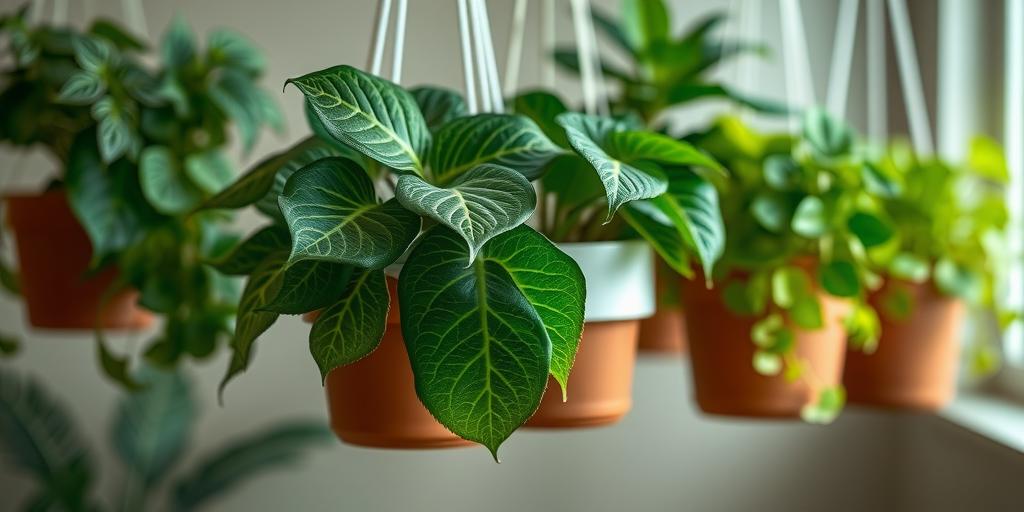
Best Low Light Hanging Plants That Thrive in Humid Bathrooms
Discover the best low-light hanging plants perfect for humid bathrooms! These easy-care, air-purifying plants add greenery and thrive in steamy, dim spaces—ideal for your bathroom oasis.
Introduction
Did you know that certain houseplants love the humidity of your bathroom? If you’ve got a dimly lit bathroom but still want lush, trailing greenery, you’re in luck! Low-light hanging plants not only survive but thrive in humid environments, purifying the air and adding a spa-like feel. From the hardy Devil’s Ivy to the elegant Boston Fern, we’ve rounded up the best plants that flourish in these conditions—no green thumb required!
Why Choose Hanging Plants for Humid Bathrooms?
Benefits of Humidity-Loving Plants in Bathrooms
Bathrooms are naturally humid spaces, making them the perfect environment for tropical plants that thrive in moisture-rich air. Many houseplants struggle in dry conditions, but in a bathroom, they get the consistent humidity they crave. This means less stress for you—no need to mist them constantly or worry about dry air causing crispy leaves. Plus, the warmth from showers creates a mini greenhouse effect, helping these plants flourish.
How Hanging Plants Save Space and Enhance Decor
Bathrooms often have limited counter or floor space, but hanging plants solve that problem beautifully. By suspending them from the ceiling, wall hooks, or shelves, you free up valuable surfaces while adding a lush, vertical element to your decor. Trailing vines like pothos or string of pearls create a cascading effect that softens hard edges and makes the space feel more inviting.
Air-Purifying Qualities of Tropical Plants
Many humidity-loving plants are also natural air purifiers. They absorb toxins like formaldehyde (found in cleaning products and some bathroom materials) and release fresh oxygen. Spider plants, pothos, and Boston ferns are especially good at this. So not only do they look great, but they also help keep your bathroom air cleaner and fresher.
Top Low Light Hanging Plants for Bathrooms
Pothos (Devil’s Ivy) – Nearly Indestructible, Thrives in Low Light
Pothos is the ultimate beginner-friendly plant. It tolerates low light, irregular watering, and still grows like crazy. Its heart-shaped leaves trail beautifully, making it perfect for hanging baskets. Plus, it comes in different varieties like golden pothos (yellow variegation) or marble queen (white and green), so you can pick one that matches your bathroom’s aesthetic.
Spider Plant – Purifies Air and Produces Baby Offshoots
Spider plants are another low-maintenance favorite. They thrive in humidity and can handle low to moderate light. One of their coolest features? They produce “spiderettes”—little baby plants that dangle from the mother plant. You can snip these off and propagate them to grow even more plants!
Boston Fern – Loves Humidity and Adds a Tropical Touch
If you want a lush, full look, a Boston fern is a great choice. These plants adore humidity and will reward you with feathery, bright green fronds. Just keep them away from direct water spray to prevent soggy soil.
Philodendron Heartleaf – Fast-Growing and Low-Maintenance
Philodendrons are similar to pothos but with slightly more delicate, heart-shaped leaves. They grow quickly, trail beautifully, and don’t need much attention. Perfect for a bathroom where you want greenery without constant upkeep.
Peperomia – Compact, Colorful, and Moisture-Loving
Peperomias come in many varieties, from the watermelon peperomia (with striped leaves) to the trailing peperomia hope. They’re small, colorful, and love humidity, making them ideal for bathrooms with limited space.
String of Pearls – Unique Trailing Succulent for Bright, Indirect Light
If your bathroom gets a bit more light (like from a frosted window), a string of pearls can be a stunning choice. This succulent has bead-like leaves that cascade down, creating a striking visual effect. Just be careful not to overwater—it still prefers to dry out slightly between waterings.
Care Tips for Low Light Hanging Plants
Watering Needs (Avoid Overwatering!)
Since bathrooms are humid, plants don’t dry out as quickly as they would in other rooms. Always check the soil before watering—stick your finger in about an inch deep. If it’s still moist, wait a few more days. Overwatering is the #1 killer of bathroom plants!
Best Soil Types for Humidity Retention
A well-draining potting mix is key to preventing root rot. Look for mixes with perlite or orchid bark to improve aeration. Some plants, like ferns, prefer slightly moisture-retentive soil, while succulents (like string of pearls) need a grittier mix.
How to Prevent Root Rot in High-Moisture Environments
Good drainage is essential. Make sure your hanging pots have holes at the bottom, and consider adding a layer of pebbles at the base to help excess water escape. If your bathroom gets steamy, crack a window occasionally to improve air circulation.
Pruning and Maintenance for Healthy Growth
Trim yellow or dead leaves regularly to keep your plants looking fresh. For trailing plants like pothos or philodendron, occasional pruning encourages bushier growth. Simply snip just above a leaf node, and new vines will sprout from that point.
Best Placement for Bathroom Hanging Plants
Near Showers vs. Away from Direct Water Spray
While plants love humidity, most don’t enjoy being drenched by shower spray. Hang them near the shower to benefit from steam but not directly in the water’s path. Exceptions? Staghorn ferns or air plants, which can handle occasional misting.
Utilizing Shelves, Hooks, and Macramé Hangers
Get creative with placement! Macramé hangers add a boho touch, while wall-mounted shelves let you stagger plants at different heights. Over-the-door hooks are great for renters who can’t drill into walls.
Avoiding Cold Drafts or Excessive Dryness
If your bathroom has a window that gets chilly in winter, keep plants away from it to avoid cold damage. Also, if you run a heater that dries out the air, consider grouping plants together to create a mini-humid microclimate.
Common Problems & Solutions
Yellowing Leaves? Could Be Overwatering or Poor Drainage
Yellow leaves often mean too much water. Check if the soil is soggy and adjust your watering schedule. If drainage is the issue, repot with a better soil mix or add more holes to the pot.
Brown Tips? Low Humidity (Rare in Bathrooms!) or Fluoride in Water
Brown tips usually indicate dry air—but since bathrooms are humid, the culprit might be tap water. Some plants (like spider plants) are sensitive to fluoride. Try using filtered or distilled water if you notice browning.
Pest Prevention in Damp Environments
Damp conditions can attract pests like fungus gnats. To prevent them, let the top layer of soil dry out between waterings, and avoid leaving standing water in saucers. Neem oil or sticky traps can help if pests appear.
By following these tips, your bathroom can become a thriving jungle of lush, healthy plants—without the hassle of high-maintenance care. Happy planting!
Conclusion
Transforming your bathroom into a green retreat is easier than you think! With the right low-light hanging plants, you can enjoy lush, thriving greenery even in the most humid, dim spaces. Whether you opt for a cascading Pothos or a delicate String of Pearls, these plants bring life and freshness to your daily routine. Ready to get started? Pick your favorite and let nature do the rest!
